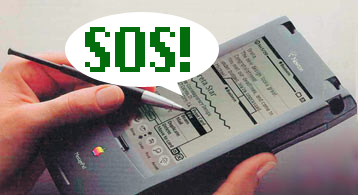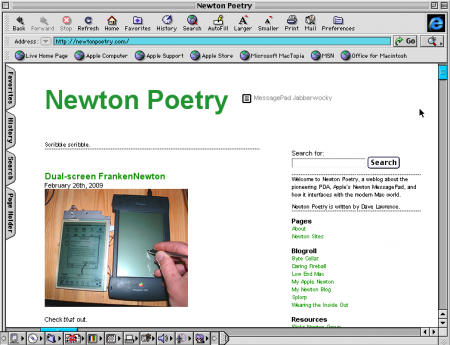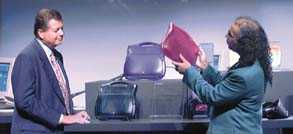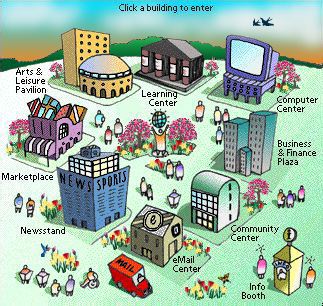May 6th, 2009

When the news broke that Yahoo! was shutting down its free Geocities web-hosting service, Newton fans wondered: what about those MessagePad fan and software sites?
Tony Kan put out the call: save those web pages!
Morgan Aldridge offered to host any that could be saved on the United Newton Network Archives (UNNA) mirror site – and, one by one, the Newton community is doing just that.
Sites like Newtonium-62 and Newton Ressurection are all being saved from the Interweb trash heap. Without this effort, a lot of Newton history, stories, and knowledge would be lost forever.
A few of the sites I have up on my own Newton Sites page will have to be re-routed to the new, UNNA-hosted URL. But it’s so worth it.
If you find a Geocities Newton site out there, lost at sea, be sure to contact Morgan.
Posted by davelawrence8 at 6:35 am on May 6th, 2009. Categories: community, newton history. Tags: free, geocities, host, internet, messagepad, newton, page, site, UNNA, web, www, yahoo. Subscribe via RSS.
April 27th, 2009
Mike Levins on his favorite programming language:
I used to say it was 1992-era Dylan. Dylan was a Lisp that Apple invented. I worked for several years on Apple’s Newton project. Newton was initially written mostly in Dylan, and I got to write a lot of OS code in Dylan. That was a time of high joy in my programming life.
It didn’t last, of course. The story of Newton’s abandonment of Dylan and its other adventures makes entertaining reading, but the short of it is that eventually I had to stop programming in Dylan.
Turns out Dylan is still around, but Levins has moved on to a Lisp dialect called Clojure.
Posted by davelawrence8 at 6:48 am on April 27th, 2009. Categories: newton history, software. Tags: apple, clojure, code, dylan, language, lisp, messagepad, newton, OS, programming. Subscribe via RSS.
April 23rd, 2009

Just a head’s-up: I’m looking for more web sites to add to my Newton Sites page.
Last October, I posted the page after collecting Newton-related web pages over the year. It was a lot of work, but way worth it. My fear was that a lot of these sites would be lost or forgotten, meaning we’d lose a lot of the history and how-to of the Newton platform.
Since then, however, I’ve been collecting more sites to add to the page – including a few more blogs, instruction sites, and old MessagePad and eMate reviews.
That’s where you come in. Browse through the page, and let me know if I’m missing something.
Posted by davelawrence8 at 6:00 am on April 23rd, 2009. Categories: links, messagepad, newton, newton history. Tags: blog, eMate, messagepad, newton, pages, sites, web, wiki. Subscribe via RSS.
April 16th, 2009
“If Apple had sold even close to 30 million Newton OS devices in its first 18 months, Apple would not have been ‘beleaguered’, they would not have bought NeXT, and Steve Jobs never would have been brought back. Instead, IDG reported that Apple sold a grand total of only 60,000 Newton units in all of 1996, the Newton’s third year on the market. That’s about how many iPhone OS devices Apple sold per day — per day! — for the first 18 months after the iPhone went on sale.”
– John Gruber at Daring Fireball, on Apple’s too-intent focus on the Next Big Thing during the 1990s.
Posted by davelawrence8 at 6:16 am on April 16th, 2009. Categories: newton history. Tags: apple, daring fireball, iphone, john gruber, messagepad, newton, next, OS, steve jobs, units. Subscribe via RSS.
April 15th, 2009

Couple of interesting things I found concerning the Newton eMate 300.
The first: a colored-eMate? From the picture above, it seems Apple (that’s former Apple CEO Gil Amelio and Frank Casanova there) had iMac-like color options slated for this particular Newton model.
Grant Hutchinson did some investigating on the multi-colored eMates, including asking Casanova where the prototypes came from, and turned up quite a few nuggets of good information.
An orange, red, or purple eMate would be a lot of fun to work with (much like my favorite Apple laptop, the clamshell iBook), but I’d love to get my hands on a clear-cased model.
The second concerns the rumored “bMate” – a business-model eMate for on-the-go writing pros. Says Pen Computing Magazine:
Journalists began snapping up eMates as the perfect portable writing tool. Even Steve Jobs liked the eMate. Apple reportedly began developing a “bMate” version for business people, featuring a better screen and a StrongARM processor. Anticipation was high for these new keyboard-equipped Newtons.
In hindsight, we can now see how the eMate’s design and ideal led to the creation of the original iBook. Salon.com quoted Apple as saying just that:
It’s also possible that Apple will release a version of the eMate based on the Macintosh operating system; the press release announcing the eMate’s demise promises that Apple “will be serving this market with Mac OS-based products beginning in 1999.”
And what do you know, the multi-colored “iMac to go” iBook G3 was released in 1999.
Posted by davelawrence8 at 6:24 am on April 15th, 2009. Categories: eMate, ibook, newton history. Tags: apple, bmate, clamshell, eMate, G3, ibook, newton, splorp. Subscribe via RSS.
March 31st, 2009
Everytime I see an “i” prefixing some word, I can’t help but think of how Apple created a naming convention that, to this day, continues to attract marketers and product designers. What began as the iMac turned into iMovie, iTunes, iPod, and eventually products ranging from that other iPhone to the iTrip and iToilet.
Now, with the iPhone, the “i” prefix continues to spread – this time to games and applications on the (get this) iTouch platform. We now have games like iDracula and apps like iBird Explorer Plus. It even extends to Mac apps like iStat Menus.
Apple is good at this kind of thing. If you think about it, Apple’s naming conventions go back as far as the “FirstNext” names for apps, like HyperCard and MacWrite, where the words are smooshed together with the second word retaining its capitalization. This naming convention has stuck all these years.
Like the ubiquitous “i” prefix, Newton product and app developers had their own prefix to work with: Newt. Just about everything that works with the Newton begins with “Newt” as a prefix.
There’s Newtris, the Tetris clone, or NewtTacToe. The web browser Newt’s Cape (say it fast for a variation of Netscape). Newtendo lets you emulate the Nintendo. Newtways let you connect peripherals. Stick “Newt” on the front of anything and you have a product for the Newton.
The prefix makes naming a product or application easy for the Newton. Take a bit of glue, glob it on the back of “Newt,” and attach it to whatever relates to the thing you want to promote. It’s easy because it doesn’t take much imagination or forethought. Like the “i,” you can throw it on anything and have a familiar-sounding yet brand-new product.
Some Newton developers used the “Newt” prefix in witty ways. Newt’s Cape is one of my favorites. Newtendo rolls of the tongue well.
But some are downright lazy. NewtGrocery? Really?
Thankfully, the “Newt” naming style didn’t last as long as the “i” prefix one has. We’re about 11 years and counting with that one, ever since Apple released the original iMac.
Maybe we could combine the two. iNewtToDo, anyone?
Posted by davelawrence8 at 5:00 am on March 31st, 2009. Categories: newton history. Tags: eMate, imac, iphone, ipod, messagepad, newtendo, newtgrocery, newton, newts cape. Subscribe via RSS.
March 23rd, 2009

Former Apple developer Chris Christensen has a lot to say about the beginnings of Apple’s former online community, eWorld, and how it grew parallel to the Newton.
Apple’s eWorld was an America Online-like online hub that was created in the early days of the Internet. Since its creation, AOL has worked closely with Apple (ever wonder why iChat automatically uses AIM accounts?), including on NewtonMail. The relationship wasn’t always beneficial to both parties, says Christensen:
[AOL] also had two engineers on their side assigned to develop a new registration system that would be appropriate for the Newton. eWorld systems engineering resources also had to be redirected to NewtonMail instead of the eWorld launch to meet the NewtonMail schedule. Thus by doing my job of adding email to the Newton I helped slow down the eWorld launch.
Christensen goes into more detail about how missed deadlines and the growth of the World Wide Web spelled doom for the fledgling eWorld community.
AOL has since declined dramatically in popularity. It was the first Internet service I used, in 1995 or 1996, back when those annoying and wasteful CD-ROMs with the AOL start-up software were mailed to everyone in America. Remember those? They made great coasters.
It’s interesting that the development of eWorld and the Newton platform were from the same division at Apple, and running pretty much side-by-side before their launch.
For nostalgia’s sake, you can download eWorld’s sound files for your Newton, or have fun with an eWorld emulator.
[Via Newtontalk.]
Posted by davelawrence8 at 6:48 am on March 23rd, 2009. Categories: newton history, software. Tags: america online, AOL, apple, community, email, eworld, internet, messagepad, newton. Subscribe via RSS.
February 25th, 2009
John Sculley’s original idea, the Knowledge Navigator – a hyper PDA of sorts, with stellar artificial intelligence and a bit of personality.
The Newton could be said to be the realization of Sculley’s concept. Watch the video, and let me know what you think. You can also download Apple’s video from UNNA.
Seems like the iPhone and our always-networked Macs are bringing some of the ideas of the Knowledge Navigator to life, but we still have a long way to go in the AI department.
Posted by davelawrence8 at 6:22 am on February 25th, 2009. Categories: newton history. Tags: AI, artificial intelligence, john sculley, knowledge navigator, messagepad, newton, PDA. Subscribe via RSS.
February 19th, 2009
Head to The Gadgeteer to read an interview with Newton MessagePad user Marisa Giancarla, who is working on another eBook reader for the Newton.
Posted by davelawrence8 at 6:23 am on February 19th, 2009. Categories: community, ebook, newton history. Tags: ebook, gadgeteer, interview, messagepad, newton, PDA. Subscribe via RSS.
February 17th, 2009
“One way to think about the NewtonOS is as a particular way of working with words, ideas, and so forth–kind of a particular way of imagining the world. If there’s no way to interact with a Newton after the coming year, this way of imagining / interacting with the world is more or less lost to us, and that’s a very sad (cultural / ideational) loss.”
– Jonathan Dueck, on the Newtontalk list, regarding the fight to get the 2010 bug resolved.
Posted by davelawrence8 at 6:33 am on February 17th, 2009. Categories: community, newton history, y2010. Tags: 2010, bug, list, newton, newtontalk, operating system, OS, quote. Subscribe via RSS.



